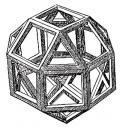Faultlines in 20th century art
From The Art and Popular Culture Encyclopedia
|
Related e |
|
Featured: |
20th century art can be divided along three axes: 'straight lines vs curvilinearity', 'Wit vs seriousness,' 'cult of beauty vs the cult of ugliness (or sexuality vs asexuality)'
This classification is indebted to the Sex in History by Gordon Rattray Taylor (see Matrism and Patrism) and the work of Camille Paglia, especially Sexual Personae. Both theorists classify along Apollonian and Dionysian axes.
Contents |
[edit]
Straight lines vs curvilinearity
- Straight lines and geometric designs: art deco, International Style, De Stijl, minimalism, cubism
- Curvilinearity: Art Nouveau, Symbolism, Surrealism
[edit]
Wit vs seriousness
- Wit: Dada, Surrealism, Pop art, Postmodernism
- Seriousness: High Modernism (literature, architecture, arts)
[edit]
Cult of beauty vs the cult of ugliness (or sexuality vs asexuality)
- Beauty: Art Nouveau, Symbolism, Art Deco
- Ugliness: High Modernism, Pablo Picasso, Samuel Beckett, Expressionism, Abstract Expressionism
[edit]
Modernism vs postmodernism
Unless indicated otherwise, the text in this article is either based on Wikipedia article "Faultlines in 20th century art" or another language Wikipedia page thereof used under the terms of the GNU Free Documentation License; or on research by Jahsonic. See Art and Popular Culture's copyright notice.

